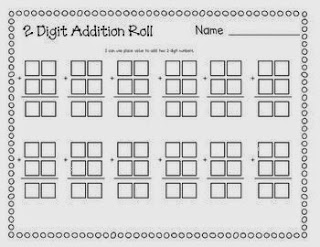After reading two articles regarding the importance of differentiation and "how-to" better differentiate I decided to dive in and try some of these strategies out in my math classroom.
I began my double-digit addition unit by providing students with a pre-test containing various problems which assessed their ability to add two and three-digit problems with and without regrouping. This pre-test, along with some observation, gave me great insight as to where my students were...and there were ALL over the board!
Seeing that I had about 3 students who had no clue how to add two-digit numbers (without any regrouping), 7 students who could confidently and consistently add two and three digit numbers with regrouping, and everywhere in between, I knew I had to create groups to address where they were at.
I decided to begin my first two classes with a whole-group mini-lesson on the steps to add two-digit numbers with no regrouping. I figured getting us all on the same page as to how I wanted them to solve these problems (and a little review for some) wouldn't hurt anyone! After these mini-lessons we then split up into three groups (based on the pre-test). (I think) I used the differentiation strategy called Tiering By Resources.
-The students who had very little understanding worked with a title para (whom I have for 30 minutes each day) using manipulatives to build and add provided numbers. They recorded their answers on a piece of paper which contained boxes to signify the top number (ones and tens) and bottom number (ones and tens).
-The group of students who showed strong understanding with solving two and three-digit problems without regrouping worked with a partner and a deck of cards (using only cards A-4..no possibility of a sum of more than 10) to create a double-digit problem and solve. They recorded these answers on a piece of grid paper and a modeled problem so they could see how to line up the numbers and separate the 10's and 1's column. After some practice time, I then signified that they may "challenge themselves" by creating 3 (OR 4!) digit problems if they felt ready for it (still no regrouping).
-Finally, for my students who fully grasped adding with and without regrouping-they were given a deck of cards (A-9) and worked to create problems on a piece of paper, provided only with the steps to solve as a reminder. While they worked I pulled two students at a time and modeled the "partial sums" strategy to help them see how to use mental math to solve these problems.
Overall, I was very pleased with how this went. Mind you, this occurred after having set the tone for "building math stamina" last week. We practiced how to work independently and in a group in a way that was productive for all and this definitely played a role in the success of this activity.


This sounds like it was a great activity for your students. I think it went well because you set the tone for your classroom in the previous week. Do you think this activity would have went as well had your students not practiced working independently?
ReplyDeleteKelly, I definitely think there would have been more struggles had we not set up that expectation. My students are not inherently independent, so I needed them to see, hear and feel what it was like to be independent. Regardless, each day won't be perfect and, when it's not, we'll stop and practice!
DeleteI was intrigued by your post because I decided to do differentiated math activities too. Did you have an adult working with each group to monitor they were doing the activities correctly and stay on task? I think the different lessons sound fun and engaging:)
ReplyDeleteJen,
DeleteI didn't have an adult with each group. I did have title support with my students who needed the most support (double-digit modeling with manipulatives). However, she only began with them, explicitly modeling how to complete the problems, they did a few as a group with her, then, when she had to leave, they finished on their own. My middle group practiced an activity we had done whole group the day before and I pulled the top group. I introduced, modeled and we did a few higher-level problems together. Once I saw they had it I left them to work independently, but with the group at the back table (so they could ask a neighbor if they had a question). I then went out to the middle group to check on their progress.
It is easy to follow what you did in your classroom for differentiation. Do you use a pre-test before every math unit? Also, how long is your math block?
ReplyDeleteLori,
DeleteI do use a pre-test before any new concept. The pre-test is usually in the form of a three-five question exit ticket on a slip of paper or an infuselearning quiz. I include a couple of lower-level, mid-level, and higher-level questions on the quiz so I know exactly where they're at and just how much they can do. The pre-tests are always really informational and help me to form some of those groups!
Our math block goes from 9:30-10:30 (warm-up, explicit whole group, then practice or group activity). We have a recess break for 15 minutes and come back from 10:45-11:15 for intervention groups (here's where I split them up based on their pre-test results).